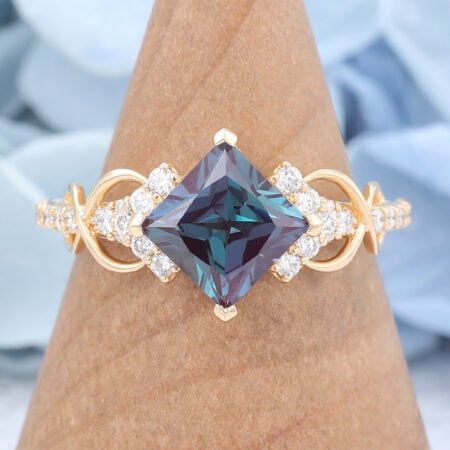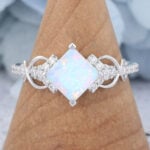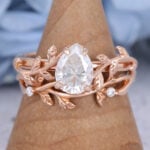Does Gold Tarnish or Rust? How to Prevent and Clean Your Jewelry
Gold is one of the most popular metals used in fine jewelry due to its beauty, rarity, and durability. Many people wonder, Does Gold Tarnish or rust over time, especially when worn daily or exposed to water and chemicals. While pure gold is highly stable and resistant to corrosion, gold alloys and lower-karat pieces can sometimes develop tarnish if not cared for properly. Understanding how and why gold tarnishes, along with effective prevention and cleaning methods, can help your jewelry maintain its shine and longevity.
What Does Tarnish and Rust Mean?
Tarnish refers to a dark film that forms on the surface of metals when they come into contact with air, moisture, or other substances. Common metals that are prone to tarnishing include silver and copper, which are often used in jewelry. It is important to note that tarnish only affects the surface of the metal and does not damage its internal structure. With regular cleaning, the metal can easily regain its shine.
Rust, on the other hand, typically occurs in iron or iron-containing alloys. When rust forms, the surface of the metal develops reddish-brown iron oxide, which not only dulls its appearance but also compromises the integrity of the metal. Over time, rust weakens the structure, reduces its strength, and can eventually cause it to break.
Does Gold Tarnish or Rust?
High-purity gold, known as 24K gold, pure gold, or solid gold, has the chemical symbol Au. As a stable precious metal, it contains no iron or other elements that react with air or water, so it does not rust. Its composition also makes it highly resistant to tarnish, allowing gold jewelry to retain its natural shine over time. However, lower-karat gold contains other metals, such as copper or silver, which can react with moisture or air and may cause slight tarnishing. Therefore, while pure gold rarely tarnishes, gold alloys can gradually lose some of their shine.
Also Read: Does 14k Gold Tarnish–What Can You Do About It?
Does White Gold Tarnish? How to Restore It?
Does gold plated jewelry tarnish how to keep plated jewelry from tarnishing
How Karat Value Affects Gold’s Resistance to Tarnish
Gold’s resistance to tarnish is closely related to its karat value. The higher the karat, the greater the gold purity and the lower the proportion of other metals like copper or silver, making it less prone to tarnishing. For instance, 24K gold is nearly pure gold, highly stable chemically, and unlikely to darken or lose its shine. In contrast, 18K or 14K gold still contains a high amount of gold but includes more alloyed metals, which can react with air, sweat, or chemicals, causing slight oxidation or darkening. This explains why high-purity gold jewelry retains its luster longer in daily wear, while lower-karat pieces require more frequent cleaning and care.
Also Read: Is 14k gold jewelry worth buying
A total guide to choosing your karat for your jewelry about 10k 14k gold and 18k gold

Everyday Habits That Can Damage or Protect Your Gold
- Chemical Exposure: Cleaners, bleach, perfume, cosmetics, and chlorine from swimming pools can react with metals like copper and silver in gold alloys, causing surface darkening or slight oxidation. Even high-purity gold alloys are more susceptible to chemical damage, even if they are stable.
- Friction and Impact: Frequent friction, impact, or scratching can cause scratches on the gold surface. Pure gold is softer and more susceptible to deformation or damage, so be careful when lifting heavy objects, exercising, or handling hard objects.
- Improper Wear: Wearing gold jewelry while washing hands, doing housework, exercising, or swimming increases the risk of exposure to moisture and chemicals, which can affect its luster. It is recommended to remove the jewelry during these occasions to minimize damage.
How to Prevent Karat Gold Jewelry from Tarnishing
Karat gold, also known as alloyed gold, is a jewelry metal made by mixing gold with other metals. Common varieties include 18K, 14K, and 10K gold. The purity and proportion of the metals in gold vary depending on the karat number. Common additions include copper, silver, nickel, and zinc to enhance hardness and durability, while also affecting color and luster. For example, rose gold primarily incorporates copper for its reddish color, while white gold is silvery-white due to nickel or palladium. While karat gold jewelry is beautiful and durable, the alloying metals can oxidize slightly due to exposure to air, sweat, or chemicals, making it important to prevent this.
- Avoid contact with chemicals: Remove karat gold jewelry when using detergents, bleach, perfume, cosmetics, or chlorine in swimming pools to reduce the chance of metals like copper and silver in the alloy reacting with the chemicals.
- Wear jewelry properly: Avoid wearing jewelry when washing hands, exercising, doing housework, or lifting heavy objects to minimize the effects of friction, impact, and sweat on the surface.
- Clean regularly: Gently wipe the surface of the jewelry with a soft metal cleaning cloth to remove dirt and skin oils, preventing surface darkening. Avoid using harsh or corrosive cleaning agents.
- Store properly: Store karat gold jewelry in a box or soft cloth bag to avoid contact with other hard objects. Keep it dry and well-ventilated to help prolong its luster.
How To Clean Tarnished Gold
- Warm Water and Soap: Place the jewelry in warm water with a small amount of mild dish soap and gently scrub with a soft brush to remove surface dirt and grease. Rinse thoroughly with clean water and dry with a soft cloth.
- Baking Soda or Toothpaste: For light tarnish, apply a small amount of baking soda or non-abrasive toothpaste to the surface of the jewelry and gently rub. Rinse thoroughly with clean water and then dry with a soft cloth.
- Professional Jewelry Cleaning Solution: There are commercially available cleaning solutions specifically for gold and karat gold. Used according to the instructions, they can safely remove tarnish and restore its luster.
- Avoid Rough or Corrosive Materials: Avoid using steel wool or corrosive chemicals when cleaning, as these can scratch or accelerate oxidation of the alloy.
- Regular Maintenance: Even after cleaning your jewelry, it should be wiped down regularly and stored separately in a dry, well-ventilated area to extend its shine and life.
Also Read: How to clean gold jewelry properly avoid these common mistakes
Common Myths About Gold Rusting
Myth 1: Gold will tarnish
In fact, pure gold (24K) does not contain metals like iron that react easily with air or water, so it does not rust. Rusting occurs when metals like iron produce oxides in the presence of oxygen and water. Gold is chemically stable and does not undergo this reaction.
Myth 2: All gold jewelry does not tarnish
While high-purity gold rarely tarnishes, karat gold or lower-purity alloys containing metals like copper and silver may oxidize slightly with sweat, air, or chemicals, causing surface darkening.
Myth 3: Gold immediately tarnishes upon contact with water or air
Gold is extremely stable and does not immediately tarnish due to contact with ordinary air or water. Surface darkening is usually caused by oxidation of other metals in the alloy or accumulation of dirt, not oxidation of the gold itself.
Myth 4: Gold jewelry requires no cleaning or maintenance
While pure gold is resistant to tarnishing, it can still pick up skin oils, makeup residue, or dust from daily wear. Regular cleaning and proper storage can help maintain the jewelry’s luster and beauty.
Gold vs. Other Precious Metals: Which Lasts Longer?
Gold vs. Silver
High-purity gold (such as 24K gold) is chemically very stable, allowing it to maintain its natural luster over time. However, gold is soft and easily scratched or deformed, so it is often mixed with other metal alloys to enhance its hardness during daily wear.
Silver has a bright luster and is relatively affordable, but it is chemically more reactive and easily reacts with sulfides in the air, causing tarnish or darkening of the surface. Long-term wear or contact with sweat, cosmetics, etc. can also accelerate oxidation of the silver surface. Therefore, silver jewelry generally requires more frequent cleaning and maintenance to maintain its luster and beauty.
Overall, gold is significantly superior to silver in terms of durability and tarnish resistance, making it more suitable for long-term wear and collection.
Also Read: Gold vs Silver Jewellery: What’s Best for Your Skin Tone & Style?
Gold vs. Platinum
Gold and platinum are both highly valuable precious metals.
Gold does not rust and rarely tarnishes.
Platinum is chemically stable and hard, making it resistant to scratching, deformation, and almost never tarnishing. While platinum’s higher density makes it slightly heavier than gold, it offers excellent wear and corrosion resistance, making it particularly suitable for long-term wear in rings and jewelry.
Overall, when simply comparing durability and tarnish resistance, platinum has a slight advantage, retaining its original luster longer. While gold is slightly softer, it offers unique advantages in aesthetics and color, making it a reliable choice for long-term wear, especially in high-purity gold jewelry.
Also Read: Is platinum better than gold a step by step comparison
Gold vs. Palladium
Palladium is a white precious metal that is chemically stable, corrosion-resistant, and tarnish-resistant. It also boasts a high hardness, is lightweight, and offers a comfortable feel. Compared to gold, palladium jewelry is more durable, less susceptible to scratches with daily wear, and requires less frequent cleaning.
In general, if durability and lightweight design are key considerations, palladium offers advantages; however, gold still holds unique appeal in terms of color, collectible value, and aesthetic appeal.
Conclusion
Overall, the answer to does gold tarnish depends on the gold’s purity and composition: higher-purity gold resists tarnish, while alloys may need regular cleaning and proper care. By following simple daily habits—avoiding harsh chemicals, storing jewelry properly, and cleaning it gently—you can keep your gold pieces looking bright and beautiful for years.
FAQs About Does Gold Tarnish or Rust
Does gold tarnish or fade over time? Does gold rust in water?
Pure gold rarely tarnishes, does not rust, while lower-karat gold may tarnish slightly over time.
Is gold magnetic? Does gold corrode or oxidize?
Pure gold is not magnetic and does not corrode or oxidize.
How is gold made? Why is gold valuable?
Gold is formed naturally in the Earth over millions of years through geological processes.It is valuable for its rarity, durability, and cultural significance.
What does gold symbolize?
It symbolizes wealth, success, and timeless beauty.
Is 10K gold or 14K gold good? Does 10K, 14K, 18K, and 24K gold tarnish?
10K and 14K gold are durable and suitable for daily wear, while higher-karat gold has more purity; lower-karat gold may tarnish slightly, 18K tarnishes less, and 24K rarely tarnishes.
Is 14K gold real? How much is 14K gold worth?
Yes, 14K gold is real gold alloy, and its value depends on the market and the amount of pure gold it contains.
Is platinum harder and better than gold? Is platinum more expensive than gold?
Platinum is harder and more durable than gold, and it is generally more expensive due to its rarity and density.
Is gold indestructible? Why is pure gold not suitable for making ornaments?
Gold is soft and can scratch or deform; pure gold is too soft for daily wear and is usually alloyed to improve durability.
What karat gold is best? Is pure gold green? Can gold change color? Does gold turn black?
18K gold offers a balance of purity and durability; pure gold is yellow and does not change color, while alloyed or low-quality gold may darken or tarnish under certain conditions.



